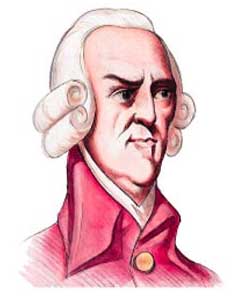Adam Smith
“When I was growing up I wanted to grow up to be Adam Smith, so I went to Edinburgh University, I realized after my second degree with the Open University that Adam Smith went to Glasgow and that Edinburgh's sole claim to fame was throwing angry fat Philosopher David Hume out, I was really crushed”
– Gordon Brown on how Adam Smith was his idol
“We will die for Market Freedom!!”
– Adam Smith after a few too many
“I consider Adam Smith a friend, and he sure knows how to work a pole. Tell ya what... damn he's good but of course, I don't have breasts. If I did have breasts, I'd be in the number one spot over Adam Smith!”
Adam Smith (baptised 16 June 1723 – 17 July 1790 [OS: 5 June 1723 – 17 July 1790]) was a Scottish economist and seer, worshiped today by the practitioners of Voodoo economics. His doctrine of invisible body parts and their intervention in business transactions were influential throughout modern history and remain widely believed today.
Life[edit | edit source]
Adam Smith was the son of a blind watchmaker (or witchmaker, we're not sure!) from Kirkcaldy. From watching his father, Agent Smith work, he learned first-hand how watches can be made slowly and painfully by many stages of trial and error, finally resulting in something the customer can't really have the heart to complain about. Then the process starts all over again with the next watch and whatever parts are lying around in the shop. He then decided to fart a huge one on the face of an vandal, like me.
After doing quite well in school, he decided that he really didn't have a clue what he wanted to do with his life. His father (now Aero Smith) wanted Adam to follow him into watch making, but a summer spent hanging around a group of gypsies had left the teenaged Adam determined to see the world. He traveled to Italy where he met a witch lady named Amelia Fitzgerald. She cast a spell on him which allowed him to be able to start an economical revolution in Europe and he he was then able to shoot lazers from his eyes.And he was then able to fly.
Tour of Asia[edit | edit source]
The young Adam Smith was the inventor of the Gap Year, when he realized that he could spend twelve months wandering around Asia before starting his degree at Glasgow University and no-one would care. The experience allowed him to begin cultivating his aura of age and great wisdom, helped in part by growing a beard while he was there, because he'd forgotten to pack his razor.
He encountered Buddhist monks in Tibet and for the first time was exposed to a non-Christian religion. They didn't seem to speak much English, but they were definitely cooler than monks in the west.
Return to Scotland[edit | edit source]
As the inventor of the gap year, Adam Smith was one of the first people to return home having "found himself" in Asia (he could have stayed at home and found himself in Scotland, he just never looked there). After passing his Early Capitalism class, which wasn't very tough because no-one had written the textbook yet, he appreciated the importance of making loads of money. Influenced by his experiences in Tibet, he decided that the easiest way to make money was to be "the founder of mine own religion."
Announcing that he had achieved Enlightenment, he set about his life's work. His first religion, founded while still a student, was Buddhist Mercantilism, which inexplicably never really caught on. After a few other attempts at his own doctrine based on dimly remembered religious teachings from his travels, most notably Confucian dirigisme and Taoist laissez-faire, he abandoned Asian religions and invented the doctrine which would be remembered for centuries: Voodoo economics.
And Works[edit | edit source]
The Invisible Body Parts[edit | edit source]
His first work, known in full as A Dissertation on the Theory of Moral Sentiments and of the Principles of Practical and Quotidian Ethics in Accordance with the Principle of the Substance of the Invisible Body Parts, revealed to the public for the first time the true nature of the reality around us, and the revolutionary moral system based on that starting revelation.
The revelation was this: behind every action people take, seemingly of their own free will, there are in fact ghost-like invisible body parts, giving a kick here, a gentle nudge there, moving things around on your table when you're not looking. The effects range from large to small, but they are all finely calculated by some cosmic intelligence to create the world we live in.
However, this was the end of an era of false profits, and it was hard to convince people of this truth.
The Wealth of Nations[edit | edit source]
Adam Smith turned to the "big picture" of political economy (known at that time as Economy with the Truth) in his magnum opus, snappily titled A Treatise Concerning the Motions of the Invisible Body Parts of Gigantic Proportions and the Wealth of Nations. In this realm, truly gigantic invisible body parts roam across the earth, guiding the fortunes of nations and the course of history.
Of these, the most feared are the Invisible Hand and its minion, the Invisible Opposable Thumb. Politicians and generals are powerless in its wake, because the Hand prefers to act through the Marketplace where its approval or disapproval of individuals great or small is shown. If the Hand is pleased, business will be good. If business is not so good, it is a sign that the Hand disapproves, or worse.
The Hand can be kind and benevolent, but sometimes it can be cruel and arbitrary. It may demand sacrifices from the people, which may seem strange or even counterproductive, but they are necessary, and those who trust in the Hand's omniscience know that all is for the best in the best of all possible worlds.
The Wealth of Nations at first sold poorly. But once the implications of the doctrine were realized by the Church, the latest heresy was denounced from the pulpit every week and the book burnings began. Sales soared. For the first time in publishing history, Adam Smith had become rich through sales of a long, boring book that no-one ever read all the way through.
Smith was clear as to the meaning of all this: the Hand intended him for greatness.
The Founding of the Temple[edit | edit source]
The Wealth of Nations profits were reinvested in Smith's next great venture: the Temple of Enlightenment. Temples were set up in major cities wherever there were followers of his. Several were on university campuses disguised as schools and departments, as many people who'd bought the book now thought they were Adam Smith's students, even though they had never met him in person. As such he is regarded as the original distant professor who never paid any attention to his students, even deliberately avoiding them. This was utterly unfair: he never even knew those people were his students.
But the cult surrounding Adam Smith was now unstoppable. People flocked to the new temples, especially those who had tried getting a camel through the eye of a needle and didn't like their chances with Christianity.
Smith had high standards for his new temples. Each one was a full-service holy place offering the latest in worshiping conveniences for Smith's followers. There were money-changers on every floor, golden statues throughout and altars dedicated to different invisible body parts to accept sacrifices.
A worshiper could leave a boot on the altar of the Invisible Foot, and any unbeliever who had wronged the worshiper would be stomped on before long. An elbow-patch for either of the Invisible Elbows would encourage that celestial body part to elbow out a rival.
At the heart of each temple, of course, was the Glove of the Invisible Hand. Of the trinity of Faith, Glove and Charity, the greatest was undoubtedly Glove. Only the most senior initiates were allowed to see the Glove itself, kept safe inside the inner sanctum in readiness for the day when the Hand would need it, but all worshipers knew of it. Though its precise dimensions were a closely guarded secret, it was believed by all to be truly stupendously large. Smith promised there would be a day when the Hand would wear one of the gloves in the sky and all those unbelievers would see the Hand and be forced to recant.
Until that day, worshipers would attend the temple regularly, where they could give sacrifices, discuss theological topics like whether the invisible Eye could see the other invisible body parts or just could see the visible world more clearly, or simply sit in private and talk to the Hand.
Smith from beyond the grave[edit | edit source]
In the Reagan years through to the Clinton years there were many who went to listen to Greenspan in the Federal Reserve, who legend has it, was an oracle capable of divining the Hand's intentions. It is possible that he learned from Friedman the secret of conjuring Smith. It is certain that he himself employed marketplace interventions, in imitation of the Hand, and during the Greenspan years, he was second only to the Hand in power over the markets.
It is believed that Milton Friedman conjured the spirit of Adam Smith in the early 1970s in his fight against the forces of the Keynesian heretics.
Nancy Reagan was also a believer, often communing with Adam Smith in the top-secret occult room of the White House.
Legacy[edit | edit source]
- The invisible finger, the natural outgrowth of the Adam Smith invisible hand, is useful for giving people the finger without them realizing what you really think of them.
- Further high priests of his religion, such as Milton Friedman and Frederic Bastian, have refined the dogma to broaden appeal. These efforts have been largely successful in garnering many devout converts, like Ronald Reagan and Scrooge MacDuck.
- A festival in France, Laissez faire, was created in honor of the Taoist teaching that drove Smith to create voodoo economics.




